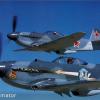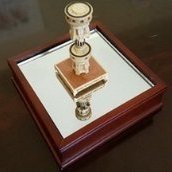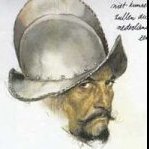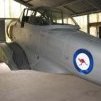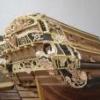MORE HANDBOOKS ARE ON THEIR WAY! We will let you know when they get here.
×
-
Posts
3,867 -
Joined
-
Last visited
Reputation Activity
-
 KeithAug got a reaction from Eddie in Endeavour 1934 by Julie Mo - Amati - Scale 1:35 - America's Cup UK J-Class Challenger
KeithAug got a reaction from Eddie in Endeavour 1934 by Julie Mo - Amati - Scale 1:35 - America's Cup UK J-Class Challenger
Julie
I found the rudder profile didn't blend very smoothly with the hull and keel which to me looked wrong. I adjusted the shape slightly as per photos.
-
 KeithAug got a reaction from tasmanian in Altair 1931 by KeithAug - FINISHED - Scale 1:32 - schooner
KeithAug got a reaction from tasmanian in Altair 1931 by KeithAug - FINISHED - Scale 1:32 - schooner
I finished the winch and a couple of minor deck fittings.
The winch base was made from brass sheet and eyelets. The holes were accurately drilled on the mill.
The winch was test assembled before painting.
Then painted with enamel paint - grey undercoat and then gloss black
A couple of other simple items were made on the lathe and mill. The hand-wheel was recovered from a pocket watch - one of a diminishing supply of such items in my odds and ends box.
The winch components were superglued together.
The fore deck components are photographed arranged in their relative positions.
-
 KeithAug reacted to tadheus in La Salamandre by tadheus - 1:24
KeithAug reacted to tadheus in La Salamandre by tadheus - 1:24
Continuation.
The beginning of the relation is available at this address:
http://5500.forumact...ndre-1-24#66516
Regards, Pawel
-
 KeithAug got a reaction from Tecko in Altair 1931 by KeithAug - FINISHED - Scale 1:32 - schooner
KeithAug got a reaction from Tecko in Altair 1931 by KeithAug - FINISHED - Scale 1:32 - schooner
I finished the winch and a couple of minor deck fittings.
The winch base was made from brass sheet and eyelets. The holes were accurately drilled on the mill.
The winch was test assembled before painting.
Then painted with enamel paint - grey undercoat and then gloss black
A couple of other simple items were made on the lathe and mill. The hand-wheel was recovered from a pocket watch - one of a diminishing supply of such items in my odds and ends box.
The winch components were superglued together.
The fore deck components are photographed arranged in their relative positions.
-
 KeithAug got a reaction from aviaamator in Altair 1931 by KeithAug - FINISHED - Scale 1:32 - schooner
KeithAug got a reaction from aviaamator in Altair 1931 by KeithAug - FINISHED - Scale 1:32 - schooner
I finished the winch and a couple of minor deck fittings.
The winch base was made from brass sheet and eyelets. The holes were accurately drilled on the mill.
The winch was test assembled before painting.
Then painted with enamel paint - grey undercoat and then gloss black
A couple of other simple items were made on the lathe and mill. The hand-wheel was recovered from a pocket watch - one of a diminishing supply of such items in my odds and ends box.
The winch components were superglued together.
The fore deck components are photographed arranged in their relative positions.
-
 KeithAug got a reaction from Nirvana in Altair 1931 by KeithAug - FINISHED - Scale 1:32 - schooner
KeithAug got a reaction from Nirvana in Altair 1931 by KeithAug - FINISHED - Scale 1:32 - schooner
I finished the winch and a couple of minor deck fittings.
The winch base was made from brass sheet and eyelets. The holes were accurately drilled on the mill.
The winch was test assembled before painting.
Then painted with enamel paint - grey undercoat and then gloss black
A couple of other simple items were made on the lathe and mill. The hand-wheel was recovered from a pocket watch - one of a diminishing supply of such items in my odds and ends box.
The winch components were superglued together.
The fore deck components are photographed arranged in their relative positions.
-
 KeithAug got a reaction from Mirabell61 in Altair 1931 by KeithAug - FINISHED - Scale 1:32 - schooner
KeithAug got a reaction from Mirabell61 in Altair 1931 by KeithAug - FINISHED - Scale 1:32 - schooner
I finished the winch and a couple of minor deck fittings.
The winch base was made from brass sheet and eyelets. The holes were accurately drilled on the mill.
The winch was test assembled before painting.
Then painted with enamel paint - grey undercoat and then gloss black
A couple of other simple items were made on the lathe and mill. The hand-wheel was recovered from a pocket watch - one of a diminishing supply of such items in my odds and ends box.
The winch components were superglued together.
The fore deck components are photographed arranged in their relative positions.
-
 KeithAug got a reaction from JamesG in Altair 1931 by KeithAug - FINISHED - Scale 1:32 - schooner
KeithAug got a reaction from JamesG in Altair 1931 by KeithAug - FINISHED - Scale 1:32 - schooner
I finished the winch and a couple of minor deck fittings.
The winch base was made from brass sheet and eyelets. The holes were accurately drilled on the mill.
The winch was test assembled before painting.
Then painted with enamel paint - grey undercoat and then gloss black
A couple of other simple items were made on the lathe and mill. The hand-wheel was recovered from a pocket watch - one of a diminishing supply of such items in my odds and ends box.
The winch components were superglued together.
The fore deck components are photographed arranged in their relative positions.
-
 KeithAug got a reaction from michael mott in Altair 1931 by KeithAug - FINISHED - Scale 1:32 - schooner
KeithAug got a reaction from michael mott in Altair 1931 by KeithAug - FINISHED - Scale 1:32 - schooner
I finished the winch and a couple of minor deck fittings.
The winch base was made from brass sheet and eyelets. The holes were accurately drilled on the mill.
The winch was test assembled before painting.
Then painted with enamel paint - grey undercoat and then gloss black
A couple of other simple items were made on the lathe and mill. The hand-wheel was recovered from a pocket watch - one of a diminishing supply of such items in my odds and ends box.
The winch components were superglued together.
The fore deck components are photographed arranged in their relative positions.
-
 KeithAug got a reaction from mtaylor in Altair 1931 by KeithAug - FINISHED - Scale 1:32 - schooner
KeithAug got a reaction from mtaylor in Altair 1931 by KeithAug - FINISHED - Scale 1:32 - schooner
I finished the winch and a couple of minor deck fittings.
The winch base was made from brass sheet and eyelets. The holes were accurately drilled on the mill.
The winch was test assembled before painting.
Then painted with enamel paint - grey undercoat and then gloss black
A couple of other simple items were made on the lathe and mill. The hand-wheel was recovered from a pocket watch - one of a diminishing supply of such items in my odds and ends box.
The winch components were superglued together.
The fore deck components are photographed arranged in their relative positions.
-
 KeithAug got a reaction from Nirvana in Altair 1931 by KeithAug - FINISHED - Scale 1:32 - schooner
KeithAug got a reaction from Nirvana in Altair 1931 by KeithAug - FINISHED - Scale 1:32 - schooner
Hello Julie
I have never tried lacquer but I must give it a go some time. Although its slow I am quite enjoying the process of applying the wipe on poly. The finish is very pleasing and I can always make progress on other stuff while I am waiting. I'm watching your build with interest and wait to see how your 2nd planking options develop?
-
 KeithAug got a reaction from KORTES in Altair 1931 by KeithAug - FINISHED - Scale 1:32 - schooner
KeithAug got a reaction from KORTES in Altair 1931 by KeithAug - FINISHED - Scale 1:32 - schooner
I am doing one coat of poly a day. Now on coat 4.
Meanwhile I have made a bit of progress on the winch.
The plan detail on the winch is basic and I also think its not very representative of the real thing.
Unfortunately the internet didn't come up with much additional information so I had to resort to a bit of intuition.
Because the winch is painted black I didn't have to bother much about the choice of materials so I used bits from my scrap box. One enhancement to the plan was the winch motor which now has a finned body - cut from a sprocket recovered from a dead printer. The fins do appear to be present on the original.
The winch has both rope and chain drives. I made these from hex section brass bar. The chain sprocket was simulated by drilling 6 radial holes using a centre drill and then filing a groove across the holes on the lathe (while rotating). The hex bar provided the reference surfaces for equi-spacing the radial holes.
The winch isn't anywhere near finished but its shaping up reasonably well.
-
 KeithAug got a reaction from Nirvana in Altair 1931 by KeithAug - FINISHED - Scale 1:32 - schooner
KeithAug got a reaction from Nirvana in Altair 1931 by KeithAug - FINISHED - Scale 1:32 - schooner
Hello Michael
Fife yachts were quite traditional even in 1931. I think the use of brass for the foot reflects the traditional / quality approach that Fife took to its Yachts built for "Gentlemen".
The following quote from Wikipedia is enlightening:
Like the schooner Altair (1931), many of the cruisers echo his turn of the century designs such as Cicely (1902) or Susanne (1906); similarly there were few fundamental differences in his ketch designs spanning this era. Perceived by some as anachronistic, these yachts were considered by many to represent some of the greatest refinements of the auxiliary cruising yacht ever achieved.
-
 KeithAug got a reaction from Nirvana in Altair 1931 by KeithAug - FINISHED - Scale 1:32 - schooner
KeithAug got a reaction from Nirvana in Altair 1931 by KeithAug - FINISHED - Scale 1:32 - schooner
Hi Bedford
I removed the machine marks with 400 grit wet and dry and then buffed the foot on the polishing wheel for about 4 minutes. The polishing wheel was primed with fine finish polishing compound.
Keith
-
 KeithAug got a reaction from 1-tamad in Endeavour by KeithAug - FINISHED - Amati - Scale 1:35 - after 1989 restoration - J Class
KeithAug got a reaction from 1-tamad in Endeavour by KeithAug - FINISHED - Amati - Scale 1:35 - after 1989 restoration - J Class
Hello Francis
I made the deck central plank from mahogany veneer. This was from a marquetry kit that I never got round to attempting. The veneer was the same thickness as the deck planks supplied with the kit - about .030 inch (0.75mm) if memory serves me well. I cut the veneer into strips about .500 inch (12.5mm) wide. I stuck the veneer down with PVA glue while it was still parallel. I cut a piece of brass strip the same width as the deck planks and I used this as a cutting guide to notch out the centre mahogany plank - using a craft knife. I notched out the centre plank and then laid the deck plank before cutting the next notch and laying the next deck plank. Its fairly important to make sure the notches in the central plank are symmetrical.
-
 KeithAug reacted to Julie Mo in Endeavour 1934 by Julie Mo - Amati - Scale 1:35 - America's Cup UK J-Class Challenger
KeithAug reacted to Julie Mo in Endeavour 1934 by Julie Mo - Amati - Scale 1:35 - America's Cup UK J-Class Challenger
Before I begin the 2nd planking, I have to get the solid wood keel right. The correct way to have done this would have been to build the keel into the skeleton, before the first plank was laid. But the solid wood keel idea didn't pop into my head until after the 1st planking was almost done. Next time... And there may be a next time just so I can do this right.
I worked this morning and some of last night getting the solid wood keel shaped correctly and closer to scale. I'm sure any seasoned pro knew it was WAY too wide before just by looking at it. Here's where I am now...
From the side profile, the keel is still to thick but I'll shape that after the 2nd planking is done.
Another idea thrown in the trash is using different woods to define the waterline and other places that would normally be painted. As I was experimenting with angles to lay the 2nd planking, I realized no wood boat planking would ever be laid at an angle on the hull except for at the waterline, where it would be parallel to the water. That change in plank orientation would weaken the hull. So I'll run all the planks at the same angle and paint the waterline in after.
-
 KeithAug got a reaction from mtaylor in Altair 1931 by KeithAug - FINISHED - Scale 1:32 - schooner
KeithAug got a reaction from mtaylor in Altair 1931 by KeithAug - FINISHED - Scale 1:32 - schooner
Hi Bedford
I removed the machine marks with 400 grit wet and dry and then buffed the foot on the polishing wheel for about 4 minutes. The polishing wheel was primed with fine finish polishing compound.
Keith
-
 KeithAug got a reaction from Eddie in Endeavour 1934 by Julie Mo - Amati - Scale 1:35 - America's Cup UK J-Class Challenger
KeithAug got a reaction from Eddie in Endeavour 1934 by Julie Mo - Amati - Scale 1:35 - America's Cup UK J-Class Challenger
Julie
Re taper planks - I dint find I needed them. The planks seemed to straighten themselves up and lay quite nicely on the keel without curvature.
You may remember I ruled lines on the hull to satisfy myself that I was happy with where the planks would fall.
I am not quite sure I understand your question re sharp edge but I would agree that as the planks approach the hull area just above the rudder you do get a sharp edge.
-
 KeithAug got a reaction from Eddie in Endeavour 1934 by Julie Mo - Amati - Scale 1:35 - America's Cup UK J-Class Challenger
KeithAug got a reaction from Eddie in Endeavour 1934 by Julie Mo - Amati - Scale 1:35 - America's Cup UK J-Class Challenger
Julie - you are nearing the stage where you start to find that the planks want to bend across their thick / stiff direction as well as bending in the normal thin / flexible direction. this double bending creates the tendency to produce the clinker effect we have previously discussed. You have a choice as this situation starts to develop. You can either continue with the parallel planks as I did with Endeavour or start to shape the planks as I did with Altair. You can make your mind up as you progress.
As you say it is important to make sure that you remove all glue from the last plank - particularly if you plan to leave it for a while. I tend to have a wet rag and a plank off cut handy (cut to a wedge). Once glued and pinned I immediately work along the line of pins - removing a few at a time and wiping the edge before replacing the pins and moving on to the next section. Once the whole plank edge has been cleaned I draw the off cut along the edge to remove any glue squeezed out by reinserting the pins.
-
 KeithAug got a reaction from Eddie in Endeavour 1934 by Julie Mo - Amati - Scale 1:35 - America's Cup UK J-Class Challenger
KeithAug got a reaction from Eddie in Endeavour 1934 by Julie Mo - Amati - Scale 1:35 - America's Cup UK J-Class Challenger
Julie - I think its looking pretty good. I have seen much more experienced builders producing far less uniform results. Well done so far.
-
 KeithAug got a reaction from Eddie in Endeavour 1934 by Julie Mo - Amati - Scale 1:35 - America's Cup UK J-Class Challenger
KeithAug got a reaction from Eddie in Endeavour 1934 by Julie Mo - Amati - Scale 1:35 - America's Cup UK J-Class Challenger
Julie - I'm please to be able to assist. There is a lot of relevant 1st and 2nd planking detail in my current build if you are interested - Altair - see below.
-
 KeithAug got a reaction from Eddie in Endeavour 1934 by Julie Mo - Amati - Scale 1:35 - America's Cup UK J-Class Challenger
KeithAug got a reaction from Eddie in Endeavour 1934 by Julie Mo - Amati - Scale 1:35 - America's Cup UK J-Class Challenger
P.S.
Julie looking at the back of your keel it looks quite consistent in thickness. Mine had a waist - see photo.
-
 KeithAug got a reaction from PeteB in Endeavour 1934 by Julie Mo - Amati - Scale 1:35 - America's Cup UK J-Class Challenger
KeithAug got a reaction from PeteB in Endeavour 1934 by Julie Mo - Amati - Scale 1:35 - America's Cup UK J-Class Challenger
Julie - I prefer to get it right - even though it will be hidden by the second planking - but many will revert to epoxy filler and as it won't be seen it will look fine.
Here is how I did it.
Firstly I didn't start at the bulb. If you work up to the bulb at least you have something to but the bulb planks up to. Here is how I did it.
I planked from the deck towards the keel until it started to become apparent that the bow profile needed to start transition from sharp to a rounded form. At this point I laid the first 3 bulb planks along the keel. One central, plus one either side.
All the keel planks need to be shaped into a trapezoidal shape and I did this by sanding using a sanding jig that I made. This was a piece of oak with a 2mm wide 1mm deep slot cut along its length. The 2mm x 2mm keel strips were place in this slot and the protruding 1mm was shaped by sanding along its length and at an angle to the surface of the oak. If you have a violin plane this might be better than sanding. The oak plank had other slots of differing thicknesses to take other planks.
I progressed with the hull planks until once again it seemed that the rounded form of the bulb needed to be fuller - I then laid the next 2 planks along the length of the bulb.
I continued in this manner until the hull and the bulb planking was complete.
My feeling was that my method was better than that suggested in the instructions.
-
 KeithAug got a reaction from cabrapente in Altair 1931 by KeithAug - FINISHED - Scale 1:32 - schooner
KeithAug got a reaction from cabrapente in Altair 1931 by KeithAug - FINISHED - Scale 1:32 - schooner
I am doing one coat of poly a day. Now on coat 4.
Meanwhile I have made a bit of progress on the winch.
The plan detail on the winch is basic and I also think its not very representative of the real thing.
Unfortunately the internet didn't come up with much additional information so I had to resort to a bit of intuition.
Because the winch is painted black I didn't have to bother much about the choice of materials so I used bits from my scrap box. One enhancement to the plan was the winch motor which now has a finned body - cut from a sprocket recovered from a dead printer. The fins do appear to be present on the original.
The winch has both rope and chain drives. I made these from hex section brass bar. The chain sprocket was simulated by drilling 6 radial holes using a centre drill and then filing a groove across the holes on the lathe (while rotating). The hex bar provided the reference surfaces for equi-spacing the radial holes.
The winch isn't anywhere near finished but its shaping up reasonably well.
-
 KeithAug got a reaction from Tecko in Altair 1931 by KeithAug - FINISHED - Scale 1:32 - schooner
KeithAug got a reaction from Tecko in Altair 1931 by KeithAug - FINISHED - Scale 1:32 - schooner
I am doing one coat of poly a day. Now on coat 4.
Meanwhile I have made a bit of progress on the winch.
The plan detail on the winch is basic and I also think its not very representative of the real thing.
Unfortunately the internet didn't come up with much additional information so I had to resort to a bit of intuition.
Because the winch is painted black I didn't have to bother much about the choice of materials so I used bits from my scrap box. One enhancement to the plan was the winch motor which now has a finned body - cut from a sprocket recovered from a dead printer. The fins do appear to be present on the original.
The winch has both rope and chain drives. I made these from hex section brass bar. The chain sprocket was simulated by drilling 6 radial holes using a centre drill and then filing a groove across the holes on the lathe (while rotating). The hex bar provided the reference surfaces for equi-spacing the radial holes.
The winch isn't anywhere near finished but its shaping up reasonably well.





